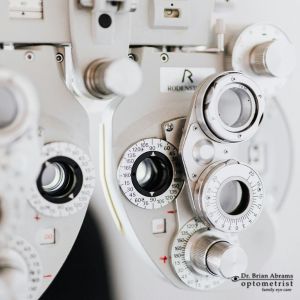Maintaining your vision is essential to your comfort, safety, and quality of life. The best way to stay on top of your vision and eye health is with regularly scheduled eye exams. Ensuring that you have an up-to-date eye exam is important for detecting vision changes and ensuring you’re taking the right steps to correct them. After visiting Dr. Brian Abrams, a trusted optometrist in Woodbridge, you’ll typically receive a prescription even if you already have glasses or an existing prescription, but for many patients, understanding what it means can be confusing. Knowing how to read your prescription gives you better control over your vision care and helps you make informed decisions about your prescription eyeglasses or contact lens options. For insight into what your prescription means and to explore options for your new glasses and lenses, visit Dr. Brian Abrams.
Here’s a guide to help you understand the numbers and abbreviations on your eye prescription.
OD, OS, and OU

Your prescription will typically be split into two sections labeled OD and OS, but sometimes you will see OU instead.
- OD (Oculus Dexter): Refers to your right eye
- OS (Oculus Sinister): Refers to your left eye
- OU (Oculus Uterque): Sometimes used to refer to both eyes
These are standard Latin abbreviations used in eye care. Each eye may have a different prescription depending on your individual vision needs, as your eyes can have different visual acuity or different conditions affecting them at various levels.
SPH (Sphere)
The Sphere value shows the degree of nearsightedness or farsightedness in diopters (the typical unit of measurement used in eye glasses prescriptions):
- A negative (-) number means you are nearsighted (difficulty seeing far away).
- A positive (+) number means you are farsighted (difficulty seeing up close).
The further the number is from zero, the stronger the prescription required. To know more about how to accommodate your eyesight, whether you are nearsighted or farsighted, book a consultation with Dr. Brian Abrams.
CYL (Cylinder) and Axis
If your prescription includes a Cylinder (CYL) value, it indicates the presence of astigmatism. Astigmatism is a relatively common condition that occurs when your cornea is irregularly shaped, causing blurry or distorted vision.
The CYL value represents how strong the astigmatism correction needs to be.
The Axis (between 1 and 180 degrees) shows the orientation of the astigmatism correction.
If there’s no CYL or Axis listed, you likely don’t have astigmatism or your astigmatism is minimal. Scheduling an eye exam at least once every two years can help you monitor the progression of astigmatism and allow Dr. Brian Abrams to make accommodations and recommendations for your eye care to mitigate the side effects of untreated worsening astigmatism.
ADD (Addition)
ADD is most often used for bifocal or progressive lenses. It represents the additional magnifying power needed for close-up tasks like reading. You’ll see this value listed when your optometrist in Woodbridge determines that you need multifocal correction due to presbyopia, a natural aging process that affects near vision.
PD (Pupillary Distance)
PD is the distance between the centers of your pupils, measured in millimeters. It ensures that lenses are correctly aligned in your glasses for clear and comfortable vision. This measurement is critical for prescription eyeglasses but may not always be included in your prescription, especially if you’re getting your glasses from a separate provider. The standard PD used in prescription eyeglasses and sunglasses is around 62mm, but the average PD for adults typically ranges between 54mm and 74mm.
Contact Lens Prescriptions
It’s important to note that a contact lens prescription is not the same as a glasses prescription. Contacts sit directly on the eye, while glasses rest a short distance away, so the measurements differ. Your eye exam for contact lenses with Dr. Brian Abrams may include additional measurements like base curve, diameter, and lens brand to account for these changes. Always use the correct prescription for the type of corrective lens you’re wearing.
Update Your Prescription with Eye Exams from Dr. Brian Abrams
Eye prescriptions can change gradually over time. If you’re experiencing headaches, squinting, eye strain, or blurry vision, you should visit Dr. Brian Abrams for an eye exam. New lenses that meet your current vision needs can make a world of difference in your everyday life.


